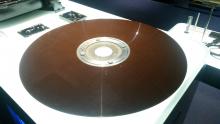
This magnetic disk was one of three which interfaced with various Control Data machines. This single platter came from a Control Data 7638 Disk Storage Subsystem and could contain up to 10MB - about the size of a few MP4's on your iPod (see page 5 in particular of http://cds.cern.ch/record/1050339/files/dd-74-35.pdf which provides a little more but rather technical explanation on how we had it set up at CERN).
As with all magnetic disk technology:
- It's an aluminum platter (disk) with magnetized coating (layer of very small magnetic particles)
- It's coated on both sides, so two surfaces contain data
- The "head" (see the 2TB disks as example - still has its arm with head visible) contains an induction coil which is used to read and write, while the platter spins (induction is the process where a moving magnetic field can create a current in a wire)
The head 'floats' a few microns above the surface of the disk - it never comes into direct contact. It can happen that the head can crash and severely scratch the disk - there is an example in the museum downstairs of a head crash where it has scored right through to the underlying aluminium base.
When comparing the 'big disk' to the others on display, it is quickly obvious that the basic design of disks has not changed over the decades. Disk evolution has been characterised by continued reduction in size and increased capacity/density per disk.
